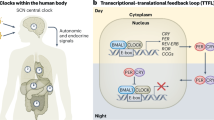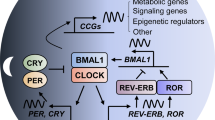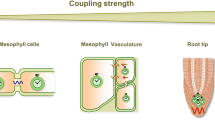Abstract
Single-cell circadian oscillators exchange extracellular information to sustain coherent circadian rhythms at the tissue level. The circadian clock and the cell cycle couple within cells but the mechanisms underlying this interplay are poorly understood. We show that the loss of extracellular circadian synchronization disrupts circadian and cell cycle coordination within individual cells, impeding collective tissue growth. We use the theory of coupled oscillators combined with live population, and single-cell recordings and precise experimental perturbations. Coherent circadian rhythms yield oscillatory growth patterns, which unveil a global timing regulator of tissue dynamics. Knocking out core circadian elements abolishes the observed effects, highlighting the central role of circadian clock regulation. Our results underscore the role of tissue-level circadian disruption in regulating proliferation, thereby linking disrupted circadian clocks with oncogenic processes. These findings illuminate the intricate interplay between circadian rhythms, cellular signalling and tissue physiology and enhance our understanding of tissue homeostasis and growth regulation in the context of both health and disease.
This is a preview of subscription content, access via your institution
Access options
Access Nature and 54 other Nature Portfolio journals
Get Nature+, our best-value online-access subscription
$32.99 / 30 days
cancel any time
Subscribe to this journal
Receive 12 print issues and online access
$259.00 per year
only $21.58 per issue
Buy this article
- Purchase on SpringerLink
- Instant access to full article PDF
Prices may be subject to local taxes which are calculated during checkout




Similar content being viewed by others
Data availability
All the data generated and used for this investigation are available via Figshare at https://doi.org/10.6084/m9.figshare.28375358.v1 (ref. 66).
Code availability
The code used in this study can be found at https://github.com/Granada-Lab/Circadian-clock-cell-cycle and https://github.com/Granada-Lab/Automatic-single-cell-tracking-of-fading-objects. We used Python v.3.8.8. and the following packages: Seaborn (v.0.11.2), Matplotlib (v.3.6.3), NumPy (v.1.23.3), pandas (v.1.4.4), SciPy (v.1.9.1), Skimage (v.0.20.0) and pyBOAT (v.0.9.1).
References
Chaix, A., Zarrinpar, A. & Panda, S. The circadian coordination of cell biology. J. Cell Biol. 215, 15–25 (2016).
Dunlap, J. C. Molecular bases for circadian clocks. Cell 96, 271–290 (1999).
Mohawk, J. A., Green, C. B. & Takahashi, J. S. Central and peripheral circadian clocks in mammals. Annu. Rev. Neurosci. 35, 445–462 (2012).
Takahashi, J. S. in A Time for Metabolism and Hormones (eds Sassone-Corsi, P. and Christen, Y.) 13–24 (Springer, 2016).
Pett, J. P., Kondoff, M., Bordyugov, G., Kramer, A. & Herzel, H. Co-existing feedback loops generate tissue-specific circadian rhythms. Life Sci. Alliance https://doi.org/10.26508/lsa.201800078 (2018).
Tahara, Y. et al. In vivo monitoring of peripheral circadian clocks in the mouse. Curr. Biol. 22, 1029–1034 (2012).
Saini, C. et al. Real-time recording of circadian liver gene expression in freely moving mice reveals the phase-setting behavior of hepatocyte clocks. Genes Dev. 27, 1526–1536 (2013).
Sinturel, F. et al. Circadian hepatocyte clocks keep synchrony in the absence of a master pacemaker in the suprachiasmatic nucleus or other extrahepatic clocks. Genes Dev. 35, 329–334 (2021).
Yoo, S. H. et al. PERIOD2::LUCIFERASE real-time reporting of circadian dynamics reveals persistent circadian oscillations in mouse peripheral tissues. Proc. Natl Acad. Sci. USA 101, 5339–5346 (2004).
Abraham, U. et al. Coupling governs entrainment range of circadian clocks. Mol. Syst. Biol. 6, 438 (2010).
Le Minh, N., Damiola, F., Tronche, F., Schütz, G. & Schibler, U. Glucocorticoid hormones inhibit food-induced phase-shifting of peripheral circadian oscillators. EMBO J. 20, 7128–7136 (2001).
Finger, A.-M. & Kramer, A. Peripheral clocks tick independently of their master. Genes Dev. 35, 304–306 (2021).
Buhr, E. D. & Takahashi, J. S. in Circadian Clocks (eds Kramer A. & Merrow, M.) 3–27 (Springer, 2013).
Damiola, F. et al. Restricted feeding uncouples circadian oscillators in peripheral tissues from the central pacemaker in the suprachiasmatic nucleus. Genes Dev. 14, 2950–2961 (2000).
Feillet, C., van der Horst, G. T. J., Levi, F., Rand, D. A. & Delaunay, F. Coupling between the circadian clock and cell cycle oscillators: implication for healthy cells and malignant growth. Front. Neurol. 6, 96 (2015).
Schafer, K. A. The cell cycle: a review. Vet. Pathol. 35, 461–478 (1998).
Golias, C. H., Charalabopoulos, A. & Charalabopoulos, K. Cell proliferation and cell cycle control: a mini review. Int. J. Clin. Pract. 58, 1134–1141 (2004).
Satyanarayana, A. & Kaldis, P. Mammalian cell-cycle regulation: several Cdks, numerous cyclins and diverse compensatory mechanisms. Oncogene 28, 2925–2939 (2009).
Hunt, T. & Sassone-Corsi, P. Riding tandem: circadian clocks and the cell cycle. Cell 129, 461–464 (2007).
Gérard, C. & Goldbeter, A. Entrainment of the mammalian cell cycle by the circadian clock: modeling two coupled cellular rhythms. PLoS Comput. Biol. 8, e1002516 (2012).
Droin, C., Paquet, E. R. & Naef, F. Low-dimensional dynamics of two coupled biological oscillators. Nat. Phys. 15, 1086–1094 (2019).
Glass, L. & Mackey, M. C. From Clocks to Chaos (Princeton Univ. Press, 1988).
Yang, Q., Pando, B. F., Dong, G., Golden, S. S. & van Oudenaarden, A. Circadian gating of the cell cycle revealed in single cyanobacterial cells. Science 327, 1522–1526 (2010).
Feillet, C. et al. Phase locking and multiple oscillating attractors for the coupled mammalian clock and cell cycle. Proc. Natl Acad. Sci. USA 111, 9828–9833 (2014).
Bieler, J. et al. Robust synchronization of coupled circadian and cell cycle oscillators in single mammalian cells. Mol. Syst. Biol. 10, 739 (2014).
Bratsun, D. A., Merkuriev, D. V., Zakharov, A. P. & Pismen, L. M. Multiscale modeling of tumor growth induced by circadian rhythm disruption in epithelial tissue. J. Biol. Phys. 42, 107–132 (2016).
Gaucher, J., Montellier, E. & Sassone-Corsi, P. Molecular cogs: interplay between circadian clock and cell cycle. Trends Cell Biol. 28, 368–379 (2018).
Smaaland, R., Sothern, R. B., Laerum, O. D. & Abrahamsen, J. F. Rhythms in human bone marrow and blood cells. Chronobiol. Int. 19, 101–127 (2002).
Bjarnason, G. A. & Jordan, R. Circadian variation of cell proliferation and cell cycle protein expression in man: clinical implications. Prog. Cell Cycle Res. 4, 193–206 (2000).
Bjarnason, G. A. et al. Circadian expression of clock genes in human oral mucosa and skin: association with specific cell-cycle phases. Am. J. Pathol. 158, 1793–1801 (2001).
Brown, W. R. A review and mathematical analysis of circadian rhythms in cell proliferation in mouse, rat, and human epidermis. J. Investig. Dermatol. 97, 273–280 (1991).
Barbason, H. et al. Circadian synchronization of liver regeneration in adult rats: the role played by adrenal hormones. Cell Prolif. 22, 451–460 (1989).
Winfree, A. T. Biological rhythms and the behavior of populations of coupled oscillators. J. Theor. Biol. 16, 15–42 (1967).
Winfree, A. T. The Geometry of Biological Time (Springer, 1980).
Kuramoto, Y. Chemical Oscillations, Waves, and Turbulence Vol. 19 (Springer, 1984).
Berg, S. et al. ilastik: interactive machine learning for (bio)image analysis. Nat. Methods 16, 1226–1232 (2019).
Finger, A.-M. et al. Intercellular coupling between peripheral circadian oscillators by TGF-β signaling. Sci. Adv. 7, eabg5174 (2021).
Yang, M. et al. TGF-β-Induced FLRT3 attenuation is essential for cancer-associated fibroblast-mediated epithelial-mesenchymal transition in colorectal cancer. Mol. Cancer Res. 20, 1247–1259 (2022).
Melisi, D. et al. LY2109761, a novel transforming growth factor beta receptor type I and type II dual inhibitor, as a therapeutic approach to suppressing pancreatic cancer metastasis. Mol. Cancer Ther. 7, 829–840 (2008).
Kim, S., Lee, J., Jeon, M., Lee, J. E. & Nam, S. J. Zerumbone suppresses the motility and tumorigenecity of triple negative breast cancer cells via the inhibition of TGF-β1 signaling pathway. Oncotarget 7, 1544–1558 (2016).
Gutu, N., Binish, N., Keilholz, U., Herzel, H. & Granada, A. E. p53 and p21 dynamics encode single-cell DNA damage levels, fine-tuning proliferation and shaping population heterogeneity. Commun. Biol. 6, 1196 (2023).
Börding, T., Abdo, A. N., Maier, B., Gabriel, C. & Kramer, A. Generation of human CrY1 and Cry2 knockout cells using duplex CRISPR/Cas9 technology. Front. Physiol. 10, 449711 (2019).
Ector, C. et al. Time-of-day effects of cancer drugs revealed by high-throughput deep phenotyping. Nat. Commun. 15, 7205 (2024).
Rahimi, A. M. et al. Expression of α-tubulin acetyltransferase 1 and tubulin acetylation as selective forces in cell competition. Cells 10, 390 (2021).
Nagoshi, E. et al. Circadian gene expression in individual fibroblasts: cell-autonomous and self-sustained oscillators pass time to daughter cells. Cell 119, 693–705 (2004).
Kaeffer, B. & Pardini, L. Clock genes of mammalian cells: practical implications in tissue culture. In Vitro Cell. Dev. Biol.: Anim. 41, 311–320 (2005).
Li, N. et al. Suprachiasmatic nucleus slices induce molecular oscillations in fibroblasts. Biochem. Biophys. Res. Commun. 377, 1179–1184 (2008).
Rogers, P. M., Ying, L. & Burris, T. P. Relationship between circadian oscillations of Rev-erbα expression and intracellular levels of its ligand, heme. Biochem. Biophys. Res. Commun. 368, 955–958 (2008).
Abaandou, L., Quan, D. & Shiloach, J. Affecting HEK293 cell growth and production performance by modifying the expression of specific genes. Cells 10, 1667 (2021).
Erzurumlu, Y., Catakli, D. & Dogan, H. K. Circadian oscillation pattern of endoplasmic reticulum quality control (ERQC) components in human embryonic kidney HEK293 cells. J. Circadian Rhythms 21, 1 (2023).
Shende, V. R., Goldrick, M. M., Ramani, S. & Earnest, D. J. Expression and rhythmic modulation of circulating microRNAs targeting the clock gene Bmal1 in mice. PLoS ONE 6, e22586 (2011).
Zheng, L., Seon, Y. J., McHugh, J., Papagerakis, S. & Papagerakis, P. Clock genes show circadian rhythms in salivary glands. J. Dent. Res. 91, 783–788 (2012).
Beta, R. A. A. et al. Core clock regulators in dexamethasone-treated HEK 293T cells at 4 h intervals. BMC Res. Notes 15, 23 (2022).
Ramanathan, C., Khan, S. K., Kathale, N. D., Xu, H. & Liu, A. C. Monitoring cell-autonomous circadian clock rhythms of gene expression using luciferase bioluminescence reporters. J. Vis. Exp. https://doi.org/10.3791/4234 (2012).
Pessina, A. et al. High sensitivity of human epidermal keratinocytes (HaCaT) to topoisomerase inhibitors. Cell Prolif. 34, 243–252 (2001).
Spörl, F. et al. A circadian clock in HaCaT keratinocytes. J. Investig. Dermatol. 131, 338–348 (2011).
Matsunaga, N. et al. 24-hour rhythm of aquaporin-3 function in the epidermis is regulated by molecular clocks. J. Investig. Dermatol. 134, 1636–1644 (2014).
Huber, A.-L. et al. CRY2 and FBXL3 cooperatively degrade c-MYC. Mol. Cell 64, 774–789 (2016).
Qu, M. et al. Circadian regulator BMAL1::CLOCK promotes cell proliferation in hepatocellular carcinoma by controlling apoptosis and cell cycle. Proc. Natl Acad. Sci. USA 120, e2214829120 (2023).
Rogatsky, I., Hittelman, A. B., Pearce, D. & Garabedian, M. J. Distinct glucocorticoid receptor transcriptional regulatory surfaces mediate the cytotoxic and cytostatic effects of glucocorticoids. Mol. Cell. Biol. 19, 5036 (1999).
Haubold, C. et al. in Focus on Bio-Image Informatics (eds De Vos, W. H. et al.) 199–229 (Springer, 2016).
Mönke, G., Sorgenfrei, F. A., Schmal, C. & Granada, A. E. Optimal time frequency analysis for biological data – pyBOAT. Preprint at bioRxiv https://doi.org/10.1101/2020.04.29.067744 (2020).
Waskom, M. Seaborn: statistical data visualization. J. Open Source Softw. 6, 3021 (2021).
Harris, C. R. et al. Array programming with NumPy. Nature 585, 357–362 (2020).
Virtanen, P. et al. SciPy 1.0: fundamental algorithms for scientific computing in Python. Nat. Methods 17, 261–272 (2020).
Gutu, N. RawData_Gutu_et_al_Circadian_Coupling_Orchestrates_Cell_growth. Figshare https://doi.org/10.6084/m9.figshare.28375358.v1 (2025).
Acknowledgements
We would like to extend our gratitude to H.-Y. Liou for his invaluable assistance in the establishment of the automatic tracking pipeline with ilastik. We thank the AMBIO imaging facility of the Charité Berlin for support in the acquisition of real-time fluorescence data. This work was financially supported by the German Federal Ministry for Education and Research through the e:Med Juniorverbund DeepLTNBC TP 3 - 01ZX1917C programme. M.S.N. and M.H.J. acknowledge support from the Independent Research Fund Denmark (Grant No. 9040-00116B) and the Novo Nordisk Foundation (Grant No. NNF20OC0064978). M.S.H. acknowledges support from the Lundbeck Foundation. C.E. is thankful for the support of the Berlin School of Integrative Oncology.
Author information
Authors and Affiliations
Contributions
N.G. and A.E.G. were responsible for conceptualization and investigation. N.G., M.S.N. and A.E.G. were responsible for developing the methodology. The experiments were run by N.G., M.K., C.E., M.M. and A.F. The results were visualized by N.G. and A.E.G. A.E.G., M.H.J. and M.S.H. acquired funding. The project was administered and supervised by A.E.G. N.G. and M.S.N. wrote the original draft of the manuscript. N.G., M.S.N., C.E. and A.E.G. reviewed and edited the manuscript. Intellectual support was provided by U.K., A.K., M.H.J., M.S.H. and H.H.
Corresponding author
Ethics declarations
Competing interests
The authors declare no competing interests.
Additional information
Publisher’s note Springer Nature remains neutral with regard to jurisdictional claims in published maps and institutional affiliations.
Supplementary information
Supplementary Information
Supplementary Figs. 1–8 and Tables 1–8.
Rights and permissions
Springer Nature or its licensor (e.g. a society or other partner) holds exclusive rights to this article under a publishing agreement with the author(s) or other rightsholder(s); author self-archiving of the accepted manuscript version of this article is solely governed by the terms of such publishing agreement and applicable law.
About this article
Cite this article
Gutu, N., Nordentoft, M.S., Kuhn, M. et al. Circadian coupling orchestrates cell growth. Nat. Phys. 21, 768–777 (2025). https://doi.org/10.1038/s41567-025-02838-4
Received:
Accepted:
Published:
Issue date:
DOI: https://doi.org/10.1038/s41567-025-02838-4
This article is cited by
-
Outside-in regulation of cellular clocks
Nature Physics (2025)



